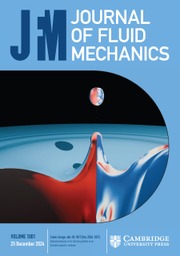Article contents
On a pair of interacting bubbles in planar Stokes flow
Published online by Cambridge University Press: 11 October 2005
Abstract
This paper presents a combined numerical and analytical investigation into various problems involving two symmetric interacting constant-pressure bubbles evolving in two-dimensional Stokes flow. The bubbles have constant surface tension on their boundaries and are taken to be in an ambient straining flow. First, a novel numerical method based on conformal mappings is presented to compute the free-surface evolution. Then, a special class of time-evolving exact solutions to the problem is derived and used to check the numerical code. These solutions reveal that, for bubbles with shrinking area, a competition between the imposed strain and surface tension can lead to either a slit or a point as the limiting shape. Numerical solutions of fixed-area bubbles are then computed and reveal that when they are forced together by a straining flow, a thin lubrication layer forms. In the absence of surface tension, large-curvature regions develop at the bubble edges and these are smoothed out by capillary effects. Further, motivated by the viscous sintering application, a study of interaction effects on the pure surface-tension-driven shrinkage of circular bubbles is investigated and compared, in an appropriate limit, to a recently derived ‘elliptical-pore model’.
- Type
- Papers
- Information
- Copyright
- © 2005 Cambridge University Press
- 8
- Cited by


